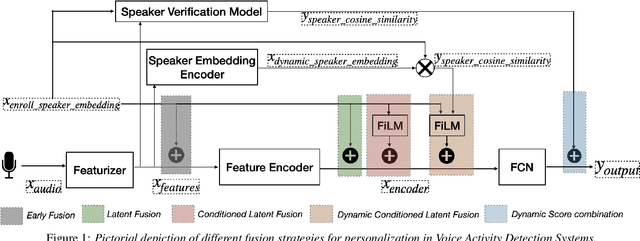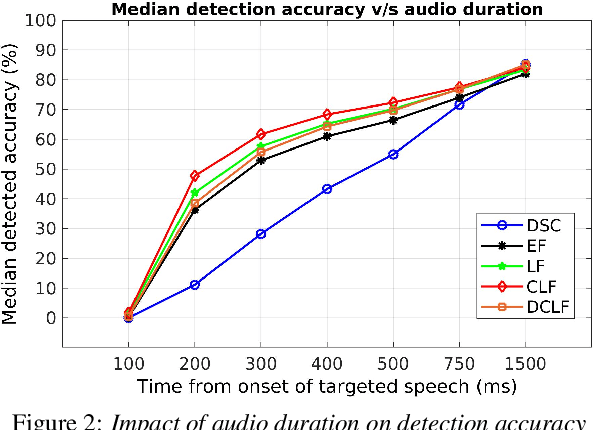Sai Srujana Buddi
Oggi
Comparative Analysis of Personalized Voice Activity Detection Systems: Assessing Real-World Effectiveness
Jun 12, 2024



Abstract:Voice activity detection (VAD) is a critical component in various applications such as speech recognition, speech enhancement, and hands-free communication systems. With the increasing demand for personalized and context-aware technologies, the need for effective personalized VAD systems has become paramount. In this paper, we present a comparative analysis of Personalized Voice Activity Detection (PVAD) systems to assess their real-world effectiveness. We introduce a comprehensive approach to assess PVAD systems, incorporating various performance metrics such as frame-level and utterance-level error rates, detection latency and accuracy, alongside user-level analysis. Through extensive experimentation and evaluation, we provide a thorough understanding of the strengths and limitations of various PVAD variants. This paper advances the understanding of PVAD technology by offering insights into its efficacy and viability in practical applications using a comprehensive set of metrics.
Streaming Anchor Loss: Augmenting Supervision with Temporal Significance
Oct 09, 2023Abstract:Streaming neural network models for fast frame-wise responses to various speech and sensory signals are widely adopted on resource-constrained platforms. Hence, increasing the learning capacity of such streaming models (i.e., by adding more parameters) to improve the predictive power may not be viable for real-world tasks. In this work, we propose a new loss, Streaming Anchor Loss (SAL), to better utilize the given learning capacity by encouraging the model to learn more from essential frames. More specifically, our SAL and its focal variations dynamically modulate the frame-wise cross entropy loss based on the importance of the corresponding frames so that a higher loss penalty is assigned for frames within the temporal proximity of semantically critical events. Therefore, our loss ensures that the model training focuses on predicting the relatively rare but task-relevant frames. Experimental results with standard lightweight convolutional and recurrent streaming networks on three different speech based detection tasks demonstrate that SAL enables the model to learn the overall task more effectively with improved accuracy and latency, without any additional data, model parameters, or architectural changes.
Efficient Multimodal Neural Networks for Trigger-less Voice Assistants
May 20, 2023



Abstract:The adoption of multimodal interactions by Voice Assistants (VAs) is growing rapidly to enhance human-computer interactions. Smartwatches have now incorporated trigger-less methods of invoking VAs, such as Raise To Speak (RTS), where the user raises their watch and speaks to VAs without an explicit trigger. Current state-of-the-art RTS systems rely on heuristics and engineered Finite State Machines to fuse gesture and audio data for multimodal decision-making. However, these methods have limitations, including limited adaptability, scalability, and induced human biases. In this work, we propose a neural network based audio-gesture multimodal fusion system that (1) Better understands temporal correlation between audio and gesture data, leading to precise invocations (2) Generalizes to a wide range of environments and scenarios (3) Is lightweight and deployable on low-power devices, such as smartwatches, with quick launch times (4) Improves productivity in asset development processes.
Converting the Point of View of Messages Spoken to Virtual Assistants
Oct 08, 2020



Abstract:Virtual Assistants can be quite literal at times. If the user says "tell Bob I love him," most virtual assistants will extract the message "I love him" and send it to the user's contact named Bob, rather than properly converting the message to "I love you." We designed a system to allow virtual assistants to take a voice message from one user, convert the point of view of the message, and then deliver the result to its target user. We developed a rule-based model, which integrates a linear text classification model, part-of-speech tagging, and constituency parsing with rule-based transformation methods. We also investigated Neural Machine Translation (NMT) approaches, including LSTMs, CopyNet, and T5. We explored 5 metrics to gauge both naturalness and faithfulness automatically, and we chose to use BLEU plus METEOR for faithfulness and relative perplexity using a separately trained language model (GPT) for naturalness. Transformer-Copynet and T5 performed similarly on faithfulness metrics, with T5 achieving slight edge, a BLEU score of 63.8 and a METEOR score of 83.0. CopyNet was the most natural, with a relative perplexity of 1.59. CopyNet also has 37 times fewer parameters than T5. We have publicly released our dataset, which is composed of 46,565 crowd-sourced samples.
 Add to Chrome
Add to Chrome Add to Firefox
Add to Firefox Add to Edge
Add to Edge